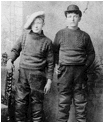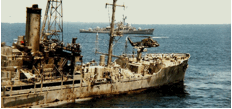Who Goes There?
In my last article I briefly talk ed about uniforms and the fact that ordinary sailors in the Royal Navy were not provided with uniforms until 1857. Prior to that date men supplied their own seagoing dress which usually reflected the type of work they were doing. If you were an ordinary sailor then virtually anything would do but cooks, sail makers, rigging experts, etc would add something suitable to their trade. It is interesting to note that the Army was very different in that uniforms for personnel on land go back a long way in history.
ed about uniforms and the fact that ordinary sailors in the Royal Navy were not provided with uniforms until 1857. Prior to that date men supplied their own seagoing dress which usually reflected the type of work they were doing. If you were an ordinary sailor then virtually anything would do but cooks, sail makers, rigging experts, etc would add something suitable to their trade. It is interesting to note that the Army was very different in that uniforms for personnel on land go back a long way in history.
The Roman legions were supplied with uniforms, so did some of Hannibal’s troops, and if you go to China and see the Terracotta Warriors you will note that even the clay figures wore different types of uniform dress. As time progressed by the middle ages there were uniformed troops in all European Armies for regular soldiers.
If war came, however, there was a call to the various noblemen raise men from amongst their tenants and these came from the land in what they usually wore to work. They brought their own weapons too – pitchforks, scythes, mattocks – anything which would inflict a nasty wound. Sedgemoor, near Bridgwater in Somerset, was the site of the final battle of the Monmouth Rebellion in 1685 and even today it is common to unearth bodies and weapons showing that weapons were very much of the ‘bring your own’ variety.
 What was the difference then between soldiers and sailors? Soldiers could spread over a large area and most battles then were hand-to-hand so that it was necessary to be able to identify someone in a melee lest you found that you had driven your battle-axe into a friendly head. Even Knights in armour had identification – styles were different and they wore sashes and ribbons as, after the visor was shut one tin can looked very much like another.
What was the difference then between soldiers and sailors? Soldiers could spread over a large area and most battles then were hand-to-hand so that it was necessary to be able to identify someone in a melee lest you found that you had driven your battle-axe into a friendly head. Even Knights in armour had identification – styles were different and they wore sashes and ribbons as, after the visor was shut one tin can looked very much like another.
Sailors, however, were different.. For most of the time in battle they were confined in a ship and all they were doing was hurling round shot at one another from a range of 50 to 100 yards. They also lived in much smaller communities so, except on very big ships, they all knew one another at least by sight. When the crew of one ship boarded another you would recognise your comrades in the fight. Only Marines, who were soldiers carried on ships, wore uniforms. When the chips are down and confusion reigns accurate identification is essential if terrible mistakes are not to be made.
The 1939-45 war at sea is littered with cases of mistaken identity, often happening in the dark or poor visibility when recognition signals were missed. In 1943 two British cruisers were patrolling off Sicily one night when they encountered two British torpedo boats. Signals were either not seen or not sent so both sets of vessels went to Action Stations. One of the cruisers fired a star shell, which illuminated the scene, and order was restored.
 Signal from cruiser to MTB ‘You were lucky – we were just about to run you down.’ Reply from Torpedo Boat, ‘So were you – we fired two torpedoes and missed!’ This incident finished up with red faces and no damage done. Not so, however, when, in 1967, the Six Days War, Israeli aircraft and torpedo boats attacked a United States ship, the USS Liberty, having mistaken her for an Egyptian: ironic, really, as the United States was one of the countries offering moral support to Israel. The result of this mistake was 34 men killed and 171 injured!
Signal from cruiser to MTB ‘You were lucky – we were just about to run you down.’ Reply from Torpedo Boat, ‘So were you – we fired two torpedoes and missed!’ This incident finished up with red faces and no damage done. Not so, however, when, in 1967, the Six Days War, Israeli aircraft and torpedo boats attacked a United States ship, the USS Liberty, having mistaken her for an Egyptian: ironic, really, as the United States was one of the countries offering moral support to Israel. The result of this mistake was 34 men killed and 171 injured!
Mistaken identity can kill. It can also result in a delay, which might be equally fatal. This is one of the reasons, which N.C.I. Watchkeepers spend so much time on learning how to identify vessels and how to tell other people where they are.
It might seem a bit academic looking at pictures of different types of yacht rig or different types of craft but look out from Pednvadan on a fine summer Sunday and you may see 25 assorted sailing boats, half a dozen RHIBs, and a variety of small boats, some fishing, some just going from A to B. As you watch it is apparent that something is wrong aboard one of the sailing craft. It might be that you then need to get on the ‘phone and tell the Coastguard what you have seen.
They will want all possible information – hull and sail colour, what type of rig, any sail numbers, what seems to be wrong and, above all, location of the casualty They decide to launch the Lifeboat. Meanwhile all of the other craft in your view are blissfully carrying on as usual, no one else has seen anything, they are too far away from the casualty. When the Lifeboat rounds Pencabe it will be confronted with an assorted mass of boats and the Coxswain will need to be directed.
 He will know roughly where the casualty is as the position fix, which you gave to the Coastguard, will have been relayed to him. But a quarter of an hour has probably elapsed between you making to first fix on our chart to give to the Coastguard and the Lifeboat’s arrival. Things will have moved, so the Coxswain will need an update, a course to steer. We do this by using a clock system in which the bow of the boat is regarded as twelve o’clock. Your first instruction to the Lifeboat will be, perhaps, ‘Steer eleven o’clock’.
He will know roughly where the casualty is as the position fix, which you gave to the Coastguard, will have been relayed to him. But a quarter of an hour has probably elapsed between you making to first fix on our chart to give to the Coastguard and the Lifeboat’s arrival. Things will have moved, so the Coxswain will need an update, a course to steer. We do this by using a clock system in which the bow of the boat is regarded as twelve o’clock. Your first instruction to the Lifeboat will be, perhaps, ‘Steer eleven o’clock’.
You will then see the Lifeboat alter course into the direction you have given and, perhaps, your next piece of information will be, ’Casualty is blue hulled ketch with white sails close to Nare Head’. You know it is a ketch because you have been taught how to recognise sailing rigs by the NCI Training Group. All being well you will now be able to watch the Lifeboat make its way to the casualty, giving you the satisfaction of a job well done.
Sailing rigs is a subject on its own, all grown from the first seedlings of scraps of skin on a pole over a dugout canoe. Some rigs have fallen in popularity but few, if any, have been discontinued. We still see square sails on large vessels, not very different from the old Roman and Greek galleys. Lugsails, common among 17th century Dutch sailing vessels are still to be found. Like everything else in the world of technology it is a continued development to fit the demands of the day. Just as well, really, as it gives us a useful tool in how to identify a particular vessel from the myriad of boats on a fine summer’s day.
